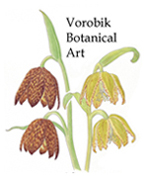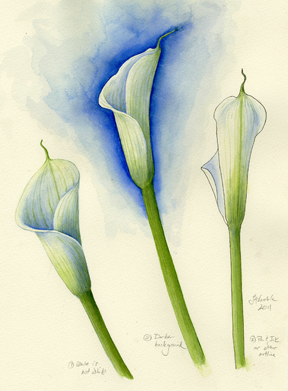
Quality Botanical Art & Affordable Prices
Vorobik Botanical Art
P.O. Box 866, Lopez Island, WA 98261. 510-520-2423. vorobik@gmail.com
All images on this site copyright Linda Ann Vorobik unless otherwise stated; Use granted only with written permission.
click for detail view
Calla Lily: Painting White Flowers
A classic watercolor excercise for different ways to paint white flowers using watercolor--click for detail view
Framed Original: $550, 16 by 20 inches
Giclee print, 16 by 20 inches. Edition 200
Cards--5 by 7 inches, on watercolor paper with a deckled edge
Calla Lily
Zantedeschia aethiopica
Araceae ~ Arum Family
For many of us this is a beloved garden plant, one that we have known since childhood. It is native to South Africa, and is a noxious weed in Australia! Although a monocot, it is not a true Lily (that is, member of the Liliaceae Family), rather it belongs to the Arum Family, which includes Western Skunk Cabbage (Lysichiton americanus), Jack-in-the-Pulpit (Arisaema triphyllum), Taro (Colocasia esculenta), Cut-leaf Philodendron (Philodendron bipinnatifidum) and many other species. All members of this family have tiny flowers on a spike (called a spadix) with a large leaf-like bract arising below it (this structure is called a spathe). This painting shows how white flowers (or spathes!) are depicted. From left to right: watercolor, no background; watercolor with dark background; watercolor with pen and ink outline.A classic exercise in botanical watercolor instruction is painting an onion, because color and shape in onions is relatively simple, and onions are naturally translucent, like watercolors. This image shows five steps for painting, beginning with lightest colors, building them up slowly in layers, and ending with dark line work and white highlights. Colors used are yellow ochre, burnt sienna, raw sienna, burnt umber, sap green, lemmon yellow, and white gouache.
